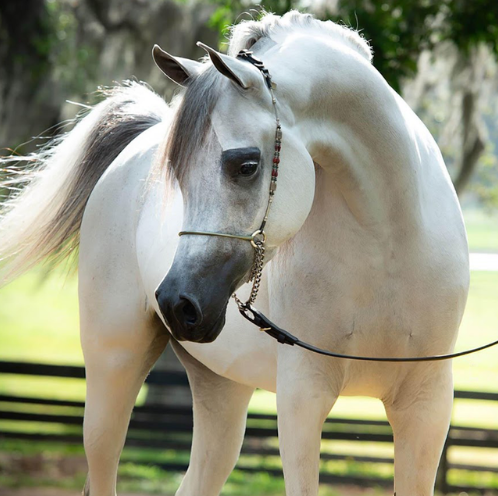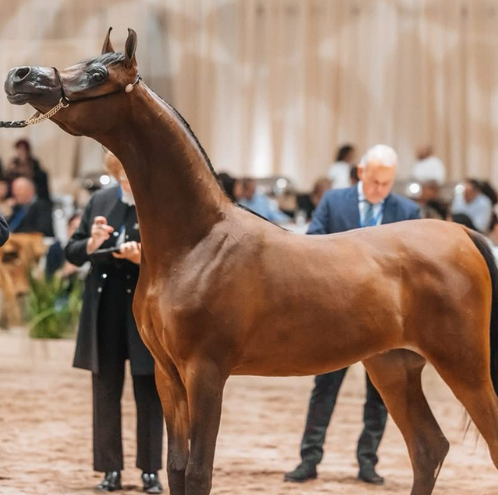Arabian Horse Bloodlines & Types
Though all purebred Arabians trace back to the same ancient desert origins, selective breeding programs worldwide have produced distinct bloodlines — each with its own look, history, and purpose. Understanding these bloodlines helps buyers, breeders, and enthusiasts make informed decisions when choosing an Arabian horse for showing, breeding, performance, or future ownership.
Today, the major internationally recognized purebred bloodline groups include Egyptian, Polish, Russian, Crabbet, Spanish, and American/Blend lines. Each carries the same core Arabian traits — intelligence, refinement, spirit, and endurance — but with different stylistic expressions.
Straight Egyptian Arabians
Egyptian-bred Arabians are considered some of the purest in the world, with bloodlines tracing directly to the desert-bred horses of the Bedouin.
Key Traits
• Ultra-refined heads with extreme type
• Large dark eyes, fine muzzle, long arched neck
• Elegant, expressive, and highly “classic” look
• Popular in halter, breeding, and preservation programs
Straight Egyptian Arabians make up less than 5% of the world’s purebred population, which increases their rarity and value.
Polish Arabians
Poland’s state studs preserved the Arabian horse through war, political upheaval, and strict government breeding programs. The result: powerful, athletic Arabians with exceptional rideability.
Key Traits
• Strong bone, balanced bodies, powerful hindquarters
• Smooth motion and excellent performance ability
• Known for soundness, structure, and stamina
• Widely used in sport, endurance, and show performance divisions
Polish Arabians often combine beauty with athletic function — a signature of the Polish breeding philosophy.
Russian Arabians
Developed primarily at Tersk Stud, Russian Arabians were bred for size, strength, and versatility while retaining classic Arabian expression.
Key Traits
• Taller, more substantial frames
• Strong toplines, upright neck carriage
• Movement with power and reach
• Successful in racing, dressage, and endurance
Many famous halter and performance champions trace back to Russian bloodlines.
Crabbet Arabians (UK)
Founded by Lady Anne and Wilfrid Blunt in the late 1800s, Crabbet bloodlines helped shape the Arabian breed in England, Australia, and the United States.
Key Traits
• Smooth, durable, all-around riding horses
• Solid bone, short backs, excellent temperaments
• Known as “the people’s Arabian” — friendly and dependable
Crabbet influence appears in many modern show and sport lines.
Spanish Arabians
Spain imported Arabians primarily from Egypt and the Middle East, developing a distinctive look that blends refinement with exotic type.
Key Traits
• Large eyes, fine muzzles, high tail carriage
• Graceful outlines and animated movement
• Known for beauty and charisma in the show ring
Spanish Arabians are less common, making them popular among collectors and heritage breeders.
Domestic / American-Blend Bloodlines
In the U.S., many Arabians are “blends” of Egyptian, Polish, Russian, Crabbet, and Spanish influences — selectively combined to create halter champions, performance athletes, or versatile family horses.
Key Traits
• Variety in style — from extreme type to sport-built
• Strong show ring presence, bold charisma
• Often bred for halter, hunter, western, or reining divisions
America now has the largest population of registered purebred Arabians in the world.
Choosing the Right Bloodline
Different bloodlines serve different goals:
| Goal | Best Bloodlines |
|---|---|
| Extreme type / halter | Egyptian, Spanish |
| Performance / sport | Polish, Russian, Crabbet |
| Versatility / riding | Crabbet, Polish, American blend |
| Preservation breeding | Egyptian, Spanish |
| Tall & athletic look | Russian, Polish blend |
No single bloodline is “best” — the right one depends on whether the owner wants to breed, show, compete, or simply enjoy a lifelong partner.
The Arabian Horse as a Global Legacy
No matter the origin — Egyptian, Polish, Russian, Spanish, Crabbet, or blended — all purebred Arabians descend from the same ancient desert horse. Their differences are stylistic, not genetic. What unites them is a shared heritage of beauty, endurance, intelligence, and loyalty — qualities that define the Arabian horse worldwide.
Contact Us for Inquiries or to Schedule a Visit
Whether you are beginning your search for a specific bloodline or exploring what type of Arabian best suits your goals, we welcome inquiries from enthusiasts, breeders, and first-time owners. Our team is always available to discuss pedigrees, temperament, and suitability.
Whether you are searching for a future show prospect, a foundation mare, or a lifelong companion, we are happy to answer questions, share pedigree details, or help guide you toward the right Arabian horse.
Phone: (630) 215-5545
Email: alameerastable@gmail.com
Location: 24224 S 88th Ave, Frankfort, IL 60423
Visiting Hours: By appointment only
INTERNATIONAL INQUIRIES WELCOME
Explore More Arabian Horse Guides
Arabian Horse Guide (Main Page)
History of the Arabian Horse
Arabian Horse Bloodlines & Types
Arabian Horse Temperament & Intelligence
Arabian Horse Care & Feeding Guide
Arabian Horse Training & Performance Disciplines
Arabian Horse Breeding & Bloodlines Overview
Arabian Horse Conformation & Anatomy
Arabian Horse Prices & Buying Guide
Arabian Horse Registration & Pedigree Papers Explained
Arabian Horse Endurance & Athletic Ability


